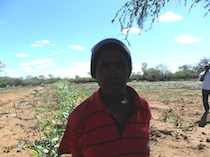ZIMBABWE: Harvesting Water for Food Security

Earth mounds running across her field hold back the water that Caroline Ndlovu uses to grow maize, pumpkins, beans and watermelons long after the short rainy season in this arid part of Zimbabwe.
Ndlovu, a mother of three who trains other farmers, is one of over 100 smallholder farmers practising the water harvesting technique of using earth dams. The water collected in the field allows farmers to increase their crop yields, which ordinarily are poor in this region.
Almost four years ago Ndlovu harvested one 50-kilogram bag of maize from her 1.5 hectare piece of land, which sits on an undulating slope. Thanks to harvesting water, Ndlovu's maize yield has quadrupled and her neighbours wonder what she is doing they are not.
'For a long time I was worried about poor harvest because of low rainfall until I heard about water harvesting,' Ndlovu, told IPS pointing to full granary of maize. 'The poor rainfall limitsed me to grow shorghum and millet but that was not for me because I am not able to (protect) the crops from the birds. I grow maize and have realised good harvests because of implementing water harvesting.'
The secret to water harvesting is hard work and a passion for farming, Ndlovu revealed. 'I work hard and put to practise the skills I have learnt on pegging and digging the contours in the most suitable location to ensure that they hold the water after the rains,' said Ndlovu.
'I have encouraged other farmers to try water harvesting and some of them wonder if I am using a tractor when they see my harvest yet it all about learning the technique and applying it correctly.'
Dead level contours are a useful technology for farmers farming on sloping fields to harvest rainwater. The trenches, around 50 centimetres deep and 1 metre wide, are dug across the slope. During rainfall, they capture run off, which is then slowly released to the field below over the next few weeks, giving crops moisture during dry spells.
Farmers have faced the challenge of not having the tools to dig the contours as well as not having the labour involved in making the contours. So communities in Sizhulube village work together to dig the contours. While older or disabled members look after the children and help prepare food.
Gwanda, 180 kilometres north of Bulawayo, is tucked away in the southern part of the country and is classified as a natural region suitable for semi extensive farming as it receives up to 400 millimetres rainfall annually. Farmers have learnt and practise rainwater harvesting to survive the long dry spells.
Village head and ward coordinator for the water harvesting project in Sizhubane village, Phineas Maphosa, said the project has empowered farmers in the area. Following a training workshop in 2006, 15 economic groups were identified in the six villages that make up the ward, which prioritised food security using water harvesting.
'Our rainfall is really pathetic and each year farmers get nothing from their fields. But now we see a difference in the harvests,' said Maphosa. 'I practise water harvesting and train other farmers on using it because I have improved my harvest as a result.'
Maphosa said at first some farmers were sceptical and lazy to adopt the technique. But ‘look and learn’ tours were used to encourage them and some now grow pumpkins and beans.
International non-governmental organisation Practical Action has trained farmers to use water harvesting techniques.
Rockwell Matengarufu, the district facilitator for Practical Action's ‘Enhancing Livelihoods and Food Security in Vulnerable Semi-Arid Areas of Matabeleland South’ programme, told IPS that water harvesting techniques are an insurance against the uncertainty of rain-fed agriculture in a changing climate. Practical Action has trained farmers to use improved farming methods and extension services they can share at village level in Gwanda.
According to the Southern and Eastern Africa Rainwater Network (SearNet) hosted by the World Agroforestry Centre in Kenya, most sub-Saharan African countries are currently using at most five percent of their rainwater potential. By recognising and incorporating the greenwater — the water ignored in hydrological planning — it may be possible to improve the food insecurity situation while also protecting the environment.
'There is an overdependence on rain-fed agriculture in sub-Saharan Africa and not enough ways to deal with the effects of dry spells and droughts,' said Maimbo Malesu, the World Agroforestry Centre's water-management programme coordinator for Eastern Africa writing on the SearNet website. 'As a result, grain yields are below one tonne per hectare in most of the region. This has mistakenly been blamed on physical water scarcity. But it is not physical as much as it is economic. There is simply a lack of investments to both capture and boost water storage.'
© Inter Press Service (2011) — All Rights ReservedOriginal source: Inter Press Service
 Global Issues
Global Issues